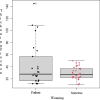Diaphragm ultrasound evaluation during weaning from mechanical ventilation in COVID-19 patients: a pragmatic, cross-section, multicenter study
- PMID: 35989352
- PMCID: PMC9392990
- DOI: 10.1186/s12931-022-02138-y
Diaphragm ultrasound evaluation during weaning from mechanical ventilation in COVID-19 patients: a pragmatic, cross-section, multicenter study
Abstract
Background: Diaphragmatic dysfunction is a major factor responsible for weaning failure in patients that underwent prolonged invasive mechanical ventilation for acute severe respiratory failure from COVID-19. This study hypothesizes that ultrasound measured diaphragmatic thickening fraction (DTF) could provide corroborating information for weaning COVID-19 patients from mechanical ventilation.
Methods: This was an observational, pragmatic, cross-section, multicenter study in 6 Italian intensive care units. DTF was assessed in COVID-19 patients undergoing weaning from mechanical ventilation from 1st March 2020 to 30th June 2021. Primary aim was to evaluate whether DTF is a predictive factor for weaning failure.
Results: Fifty-seven patients were enrolled, 25 patients failed spontaneous breathing trial (44%). Median length of invasive ventilation was 14 days (IQR 7-22). Median DTF within 24 h since the start of weaning was 28% (IQR 22-39%), RASS score (- 2 vs - 2; p = 0.031); Kelly-Matthay score (2 vs 1; p = 0.002); inspiratory oxygen fraction (0.45 vs 0.40; p = 0.033). PaO2/FiO2 ratio was lower (176 vs 241; p = 0.032) and length of intensive care stay was longer (27 vs 16.5 days; p = 0.025) in patients who failed weaning. The generalized linear regression model did not select any variables that could predict weaning failure. DTF was correlated with pH (RR 1.56 × 1027; p = 0.002); Kelly-Matthay score (RR 353; p < 0.001); RASS (RR 2.11; p = 0.003); PaO2/FiO2 ratio (RR 1.03; p = 0.05); SAPS2 (RR 0.71; p = 0.005); hospital and ICU length of stay (RR 1.22 and 0.79, respectively; p < 0.001 and p = 0.004).
Conclusions: DTF in COVID-19 patients was not predictive of weaning failure from mechanical ventilation, and larger studies are needed to evaluate it in clinical practice further. Registered: ClinicalTrial.gov (NCT05019313, 24 August 2021).
Keywords: COVID-19; Diaphragm; Mechanical ventilation; Ultrasound; Weaning failure.
© 2022. The Author(s).
Conflict of interest statement
The authors declare that they have no competing interests.
Figures



Similar articles
-
[Predictive value of diaphragmatic thickening fraction combined with MRC score for the outcome of weaning from mechanical ventilation in ICU-acquired weakness patients].Zhonghua Wei Zhong Bing Ji Jiu Yi Xue. 2023 Oct;35(10):1080-1084. doi: 10.3760/cma.j.cn121430-20230404-00241. Zhonghua Wei Zhong Bing Ji Jiu Yi Xue. 2023. PMID: 37873714 Chinese.
-
Diaphragmatic ultrasonography-based rapid shallow breathing index for predicting weaning outcome during a pressure support ventilation spontaneous breathing trial.BMC Pulm Med. 2022 Sep 7;22(1):337. doi: 10.1186/s12890-022-02133-5. BMC Pulm Med. 2022. PMID: 36071420 Free PMC article.
-
[Predictive value of diaphragm thickening fraction and intra-abdominal pressure monitoring-oriented risk prediction model for weaning failure in patients with severe acute pancreatitis].Zhonghua Wei Zhong Bing Ji Jiu Yi Xue. 2023 Feb;35(2):177-181. doi: 10.3760/cma.j.cn121430-20220930-00873. Zhonghua Wei Zhong Bing Ji Jiu Yi Xue. 2023. PMID: 36916378 Chinese.
-
Accuracy of respiratory muscle assessments to predict weaning outcomes: a systematic review and comparative meta-analysis.Crit Care. 2024 Mar 7;28(1):70. doi: 10.1186/s13054-024-04823-4. Crit Care. 2024. PMID: 38454487 Free PMC article.
-
Ultrasound assessment of diaphragmatic dysfunction as a predictor of weaning outcome from mechanical ventilation: a systematic review and meta-analysis.BMJ Open. 2018 Oct 4;8(9):e021189. doi: 10.1136/bmjopen-2017-021189. BMJ Open. 2018. PMID: 30287605 Free PMC article.
Cited by
-
Predictive Value of Diaphragm and Lung Ultrasonography for Weaning Failure in Critically Ill Patients with Acute Respiratory Failure Due to COVID-19 Pneumonia.Diagnostics (Basel). 2024 Oct 11;14(20):2263. doi: 10.3390/diagnostics14202263. Diagnostics (Basel). 2024. PMID: 39451587 Free PMC article.
-
Diaphragm muscle parameters as a predictive tool for weaning critically ill patients from mechanical ventilation: a systematic review and meta-analysis study.Eur J Transl Myol. 2024 Sep 3;34(3):12642. doi: 10.4081/ejtm.2024.12642. Eur J Transl Myol. 2024. PMID: 39228235 Free PMC article.
-
Diaphragm Ultrasound in Different Clinical Scenarios: A Review with a Focus on Older Patients.Geriatrics (Basel). 2024 May 30;9(3):70. doi: 10.3390/geriatrics9030070. Geriatrics (Basel). 2024. PMID: 38920426 Free PMC article. Review.
-
Barotrauma during Noninvasive Respiratory Support in COVID-19 Pneumonia Outside ICU: The Ancillary COVIMIX-2 Study.J Clin Med. 2023 May 25;12(11):3675. doi: 10.3390/jcm12113675. J Clin Med. 2023. PMID: 37297869 Free PMC article.
-
Ultrasonographic Assessment of Diaphragmatic Function and Its Clinical Application in the Management of Patients with Acute Respiratory Failure.Diagnostics (Basel). 2023 Jan 23;13(3):411. doi: 10.3390/diagnostics13030411. Diagnostics (Basel). 2023. PMID: 36766515 Free PMC article. Review.
References
-
- Corradi F, Vetrugno L, Orso D, Bove T, Schreiber A, Boero E, et al. Diaphragmatic thickening fraction as a potential predictor of response to continuous positive airway pressure ventilation in COVID-19 pneumonia: a single-center pilot study. Respir Physiol Neurobiol. 2021;284:103585. doi: 10.1016/j.resp.2020.103585. - DOI - PMC - PubMed
Publication types
MeSH terms
Associated data
LinkOut - more resources
Full Text Sources
Medical

